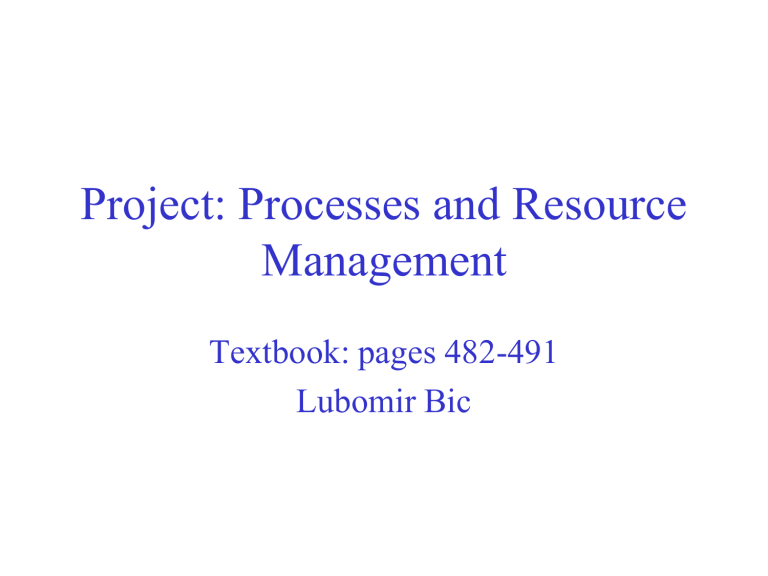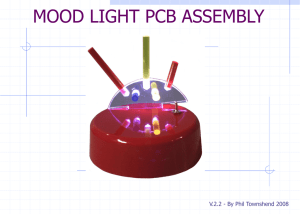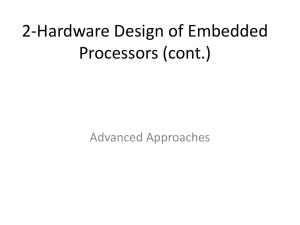Lecture Notes

Project: Processes and Resource
Management
Textbook: pages 482-491
Lubomir Bic
Assignment
• Design/implement a simplified process and resource manager
• Required functionalities:
– process: create/destroy
– resource: request/release
– time-out interrupt
– multi-unit resources (5.1. page 490 of textbook)
– extensive error checking
Operating Systems
2
Overall Organization
• Problem: we do not have the actual processes or hardware
• Solution: your terminal (or test files) represent
– currently running process, and
– the hardware causing interrupts
Operating Systems
3
Overall Organization
• Write presentation/test shell
– it reads command from terminal or test file
– it invokes kernel function
– it displays reply (on terminal or to output file)
• which process is running
• any errors your terminal/ test files repeat get f, par invoke f(par) get reply display reply
Process and
Resource
Manager
Operating Systems
4
Example:
Presentation/test shell
* Process Init is running
. . .
shell> cr A 1
*Process A is running shell> cr B 2
*Process B is running shell> cr C 1
*Process B is running shell> req R1,1
*Process B is blocked; Process A is running
. . .
Operating Systems
5
Process states and operations
• Process states: ready, running, blocked
• Possible Operations:
– Create: (none) ready
– Destroy: running/ready/blocked
(none)
– Request: running blocked
– Release: blocked ready
– Time_out: running ready
– Scheduler: ready running/running
ready
Operating Systems
6
Process Control Block (PCB)
• PID
• CPU state — not used
• Memory — not used
• Open_Files — not used
• Other_resources
•
Status: Type & List
• Creation_tree: Parent/Children
• Priority: 0, 1, 2 (Init, User, System)
Operating Systems
7
The Ready List (RL)
•
3-level priority list
2 = “system”
1 = “user”
0 = “init”
• Priorities don’t change
• Every process (PCB) is either on the RL on a blocked list
Operating Systems
8
Create a process
Create(initialization parameters){ create PCB data structure initialize PCB using parameters link PCB to creation tree insert(RL, PCB)
Scheduler() }
•
Init process is created at start-up & can create first system or user process
• Any new or released process is inserted at the end of the queue (RL)
Operating Systems
9
Destroy a process
Destroy (pid) { get pointer p to PCB using pid
Kill_Tree(p)
Scheduler() }
Kill_Tree(p) { for all child processes q Kill_Tree(q) free resources delete PCB and update all pointers }
• Process can be destroyed by any of its ancestors or by itself (exit)
Operating Systems
10
Representation of Resources
• There is a fixed set of resources
• Resource Control Block (RCB)
– RID
–
Status : counter for number of free units
– Waiting_List : list of blocked processes
Operating Systems
11
Request resource (1-unit resources)
Request(rid) { r = Get_RCB(rid); if (r->Status == 'free') { r->Status = 'allocated‘; insert(self->Other_Resources, r);
} else { self->Status.Type = 'blocked'; self->Status.List = r; remove(RL, self); insert(r->Waiting_List, self);
Scheduler(); }
• all requests are satisfied in strict FIFO order
Operating Systems
12
Release resource (1-unit resources)
Release(rid) { r = Get_RCB(rid); remove(self->Other_Resources, r); if (r->Waiting_List == NIL} { r->Status = 'free';
} else { remove(r->Waiting_List, q); q->Status.Type = 'ready'; q->Status.List = RL; insert(q->Other_Resources, r); insert(RL, q);
Scheduler(); }}
Operating Systems
13
Scheduling
• 3-level priority scheduler
• Use preemptive round-robin scheduling within level
• Time sharing is simulated by function call
• Init process serves a dual purpose:
– dummy process: lowest priority/never blocked
– root of process creation tree
Operating Systems
14
Scheduler
• Called at the end of every kernel call
(1) Scheduler() {
(2) find highest priority process p
(3) if (self->priority < p->priority ||
(4) self->Status.Type != 'running' ||
(5) self == NIL)
(5) preempt(p, self) }
Condition (3): called from create or release
Condition (4): called from request or time-out
Condition (5): called from destroy
Preemption:
• Change status of p to running (status of self already changed to ready/blocked)
• Context switch—output name of running process
Operating Systems
15
Time-out Interrupts
• Simulate time-sharing
Time_out() { find running process q; remove(RL, q); q->Status.Type = 'ready'; insert(RL, q);
Scheduler();}
Operating Systems
16
Presentation/Test Shell
• Mandatory Commands
– init
– cr <name> <priority>
– de <name>
– req <resource name> <# of units>
– rel <resource name> <# of units>
– to
Operating Systems
17
Presentation/Test Shell
• Optional commands (examples):
– list all processes and their status
– list all resources and their status
– provide information about a given process
– provide information about a given resource
Operating Systems
18
Summary of tasks
• Design/implement the process and resource manager
– data structures and functions
• Design/implement a driver program (shell)
– command language and interpreter
• Instantiate the manager to include at start-up:
– A Ready List with 3 priorities
– A single process, Init
– 4 resources labeled: R1, R2, R3, R4 (each Ri has i units))
• Submit your program for testing, submit documentation for evaluation
Operating Systems
19
Sample test 1
cr x 2 cr y 1 to cr z 2 to req R1 1 to req R1 1 de z rel R1 1 de x init x x x x z z x z x x init
20
Sample test 2
cr x 1 cr p 1 cr q 1 cr r 1 to req R2 1 to req R3 3 to req R4 3 to to req R3 1 req R4 2 req R2 2 to de q to to init x x x x p p q q r r x p q r x x x p x 21







